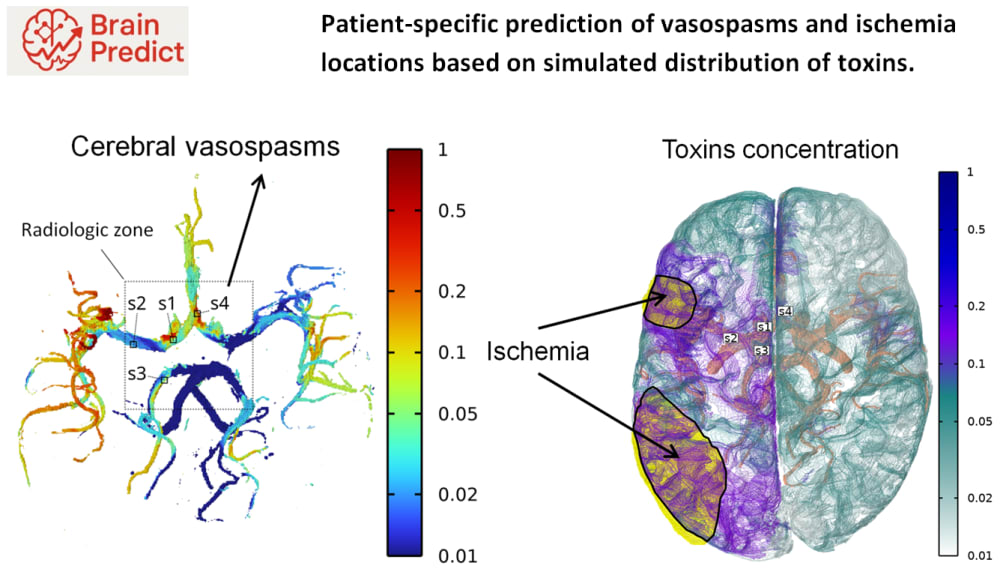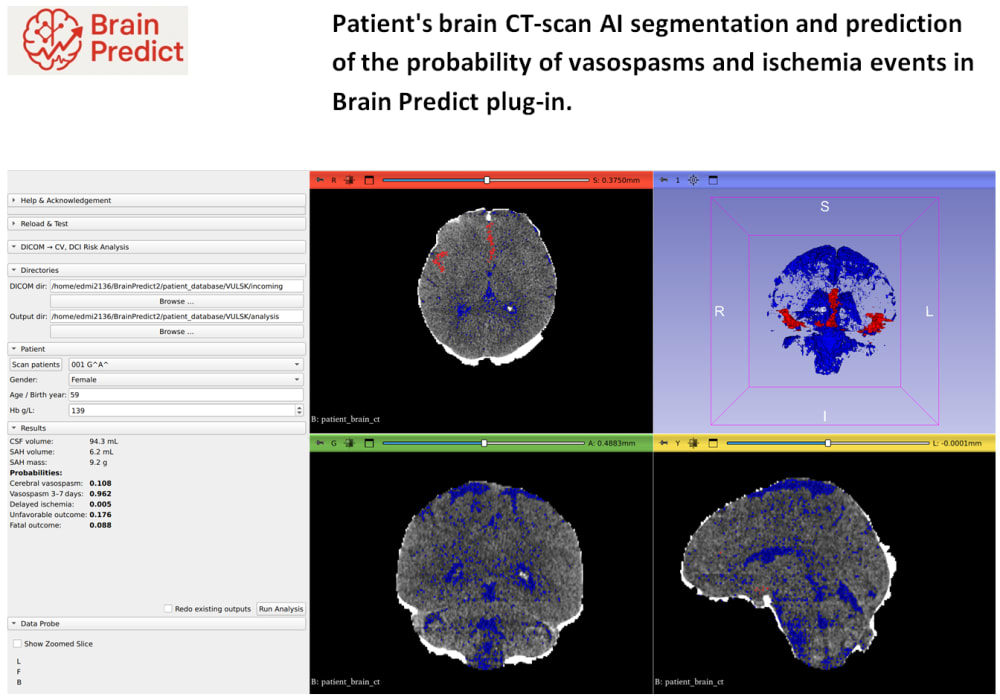The Brain Predict offers an original and cutting-edge computer simulation system that utilizes Artificial Intelligence and COMSOL Multiphysics patient-specific modeling for the prediction of cerebral arteries vasospasms (CV) and delayed cerebral ischemia (DCI) following spontaneous subarachnoid hemorrhage (SAH).
SAH is a type of stroke associated with high rates of mortality and morbidity. Worldwide, approximately 700,000 cases occur each year, and up to 70% of survivors develop CV and DCI between post-ictal days 3–21, contributing to 40% mortality and 30% long-term disability. Timely prediction of CV/DCI following SAH is vital for selecting personalized and timely therapeutic tactics. However, there is currently no radiological software capable of predicting CV/DCI after SAH.
The proposed solution is a software platform that delivers patient specific, spatially resolved CV/DCI risk predictions immediately after repair of a ruptured cerebral arterial aneurysm, enabling targeted prevention and early intervention.
INNOVATION
The leaked blood breakdown in the subarachnoid space generates toxins, which can result in the constriction of cerebral arteries and triggering CV and DCI.
Our primary innovation is a developed COMSOL model that numerically simulates toxins transport by the cerebrospinal fluid (CSF). This model allows to predict the location and probability of CV and DCI. The model incorporates standard patient's clinical data and modeling of the CSF flow. The CSF flow model incorporates cerebral ventricles, subarachnoid space, and periarterial spaces around arteries segmented from MRI-angiography scans of the model brain.
How it works:
Firstly, the CT scan of patient’s brain is used by the convolutional neural network to automatically segment hematoma volume, CSF volume, and cerebral arteries.
Secondary, the obtained patient data is used in COMSOL to simulate the distribution of toxins concentration on the walls of cerebral arteries.
Finally, the CSF volume ratio to hemorrhage volume predicts the probability of CV/DCI occurring. CV/DCI location is predicted by the distribution of toxins.
FEASIBILITY
At this stage, AI segmentation of the patient’s brain CT scan, the estimation of the CSF and hemorrhage volumes, and the prediction of CV/DCI occurrence probability are implemented as plug-in for the open-source 3D Slicer software. The simulation of toxins transport and prediction of CV/DCI events location are implemented in the COMSOL Multiphysics framework. The Brain Predict system operates within a workstation with no additional hardware necessary. The technology readiness level is currently at TRL 6: the prototype is successfully tested in Kaunas Technology University and Vilnius University Hospital.
The subsequent phase of the development process will entail facilitating the installation and utilization of the system. It will be containerized using Docker software, and only require on-site adaption to operate with the PACS server and COMSOL licenses server.
MARKETABILITY
Health-economic modeling indicates potential savings of 44,000 USD per patient during the first year by reducing ICU stay and preventing ischemic consequences.
- Consumers: approximately 100 developers of software and hardware for radiological analysis and CT visualization.
- Users: more than 20,000 hospitals (ICUs, Radiological departments) globally.
- Potential: The global AI - based software for radiology market is 1.2 billion USD, CAGR is 27%.
Like this entry?
-
About the Entrant
- Name:Algis Dziugys
- Type of entry:teamTeam members:
- Algis Dziugys
- Vytautas Petkus
- Edgaras Misiulis
- Vytenis Ratkunas
- Robertas Alzbutas
- Aidanas Preiksaitis
- Tomas Iesmantas
- Software used for this entry:COMSOL Multiphysics, 3D Slicer, Python
- Patent status:pending






